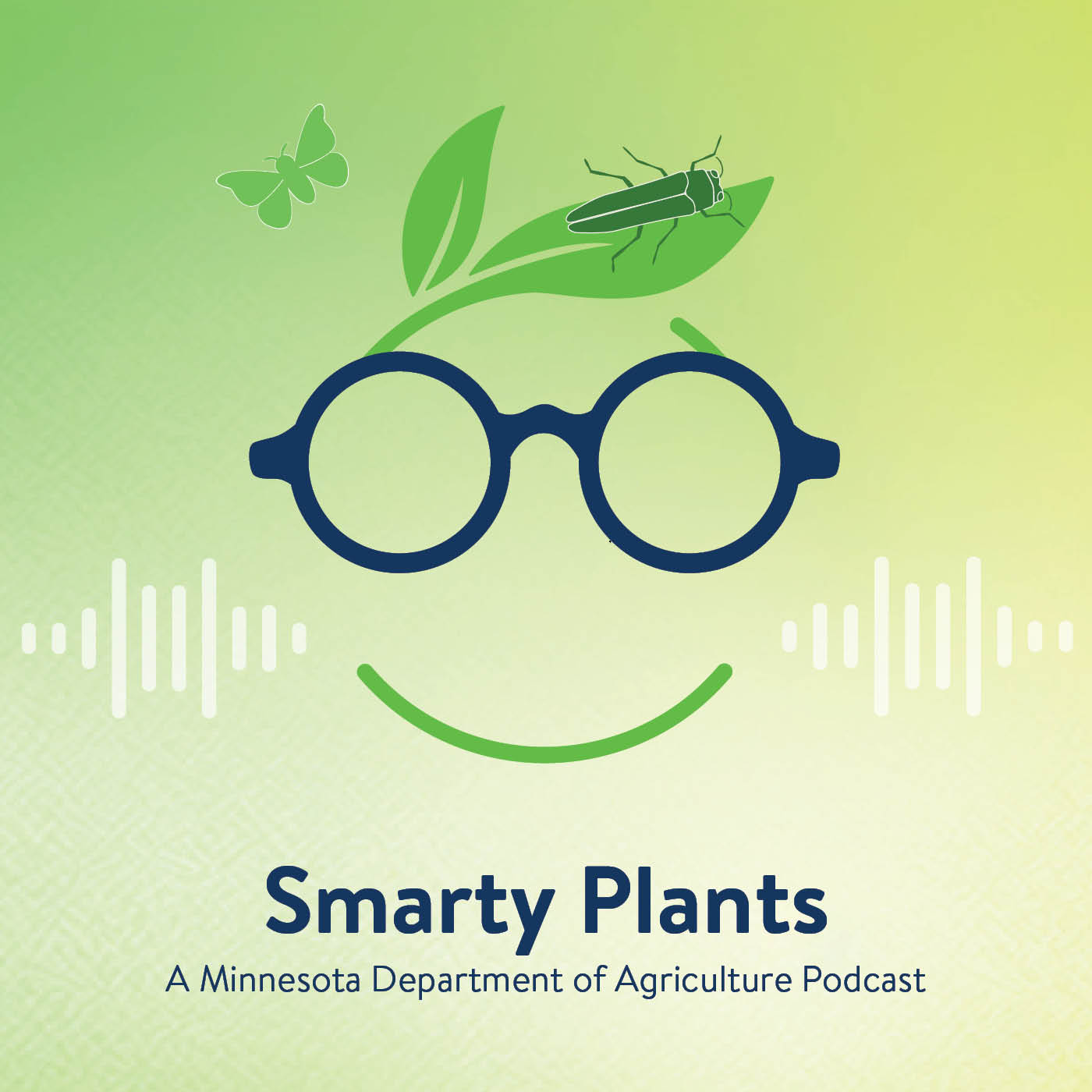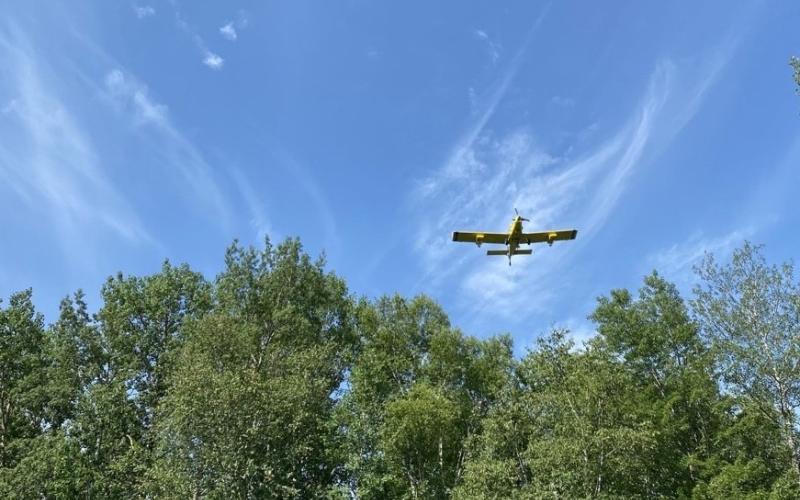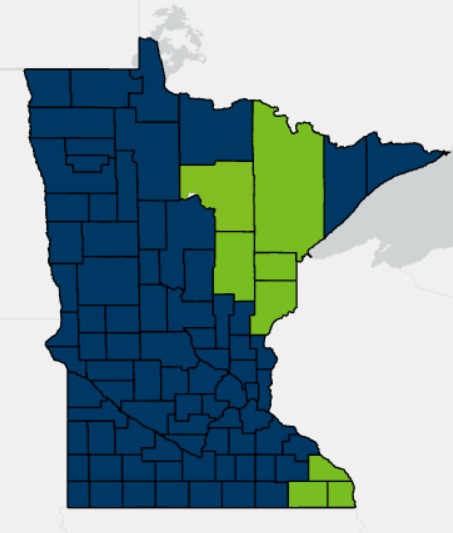Return to spongy moth main menu
IMPORTANT MANAGEMENT UPDATE
For decades, a partnership between the Minnesota Department of Agriculture (MDA), ten states, and the USDA (United States Department of Agriculture) Forest Service, the national Slow the Spread (STS) program has effectively reduced the spread of spongy moth populations; an invasive and destructive forest pest, by greater than 60%. The MDA has used aerial spongy moth management to protect our state from devastating forest damage and significant economic losses.
Due to budget uncertainties and significant allocation delays within the USDA Forest Service, the MDA was notified that Minnesota would not receive the federal funding needed in time for proper implementation of Btk aerial management operations. This has forced the MDA to cancel all Btk management for 2025, which was 12 high-priority spongy moth infestations in five Minnesota counties totaling 2,752 acres.
Specifically, these cuts affect treatments in Anoka, Carlton, Itasca, St. Louis, and Winona counties, and the cities of Coon Rapids, Grand Rapids, and Winona.
As a result, the MDA will be removing all proposed Btk management areas from our treatment map, and closing all Btk email/text notification signups.
The MDA is still moving forward with all proposed mating disruption (product SPLAT GM-O) treatments. The MDA will continue to work within our state program to monitor spongy moth populations and to advocate for the best possible management strategies in the future.
Spongy Moth Management
The Minnesota Department of Agriculture (MDA), with federal, state, and local partners, manage spongy moth populations to slow the spread of this invasive insect. The MDA is part of a national management program called Slow the Spread that guides management strategies. Spongy moth trap catches, alternate life surveys, and size of management areas determine the type of management action.
Bacillus thuringiensis kurstaki (Btk) formulated in the product Foray, is used in areas that have many male moths captured and egg masses are found during the alternate life stage survey. It is used where there is evidence of a reproducing population.
The mating disruption product SPLAT GM-O is used in areas where a low population of spongy moth was detected.
Both types of management activities use aircrafts that make repeated passes over each management block. It will be low (about 100-200 feet above the treetops), and loud. This aircraft deploys one of the two products.
2025 Proposed Management Activities
2025 Public Meetings
Residents in proposed treatment areas and the public are invited to attend an informational meeting to learn more about the insect and the management methods. Register for virtual meetings by clicking on the links below. Pre-registration is not required. To join the meeting you will need to provided your name and email address. A link to get into the meeting will be sent to your email provided.
| Date/Time | Description | Location |
|---|---|---|
| March 18, 2025 6:00-7:00 p.m. |
Information on proposed management activities in southeast Minnesota (Fillmore, Houston, and Winona counties.) |
Virtual |
| March 19, 2025 4:30 – 6:30 p.m. |
Open house on proposed Btk management to take place in the City of Coon Rapids. |
Sand Creek Park Community Room 1008 Northdale Blvd NW Coon Rapids, MN 55448 |
| March 20, 2025 6:00-7:00 p.m. |
Information on proposed management activities in northeast Minnesota (Pine, Carlton, Aitkin, St. Louis, and Itasca counties.) |
Virtual |
Individuals with a disability who need a reasonable accommodation to participate in this event please contact event organizer Matt Gallo at 507-384-1129 or through the Minnesota Relay Service at 711 as soon as possible.
Stay Updated on Spongy Moth Management in Your Area
Product Questions
The MDA uses the product SPLAT GM-O for mating disruption. SPLAT GM-O is used in areas where low populations of spongy moth have been detected.
Mating disruption uses pheromone-based products to confuse adult moths and prevent them from reproducing. Mating disruption floods the area with the scent of the female moth and confuses male spongy moths so they cannot find females. They die without reproducing. The product does not actually kill moths.
Pheromones are non-toxic compounds that insects use to communicate. The female spongy moth does not fly and must attract the male moths with pheromones.
SPLAT GM-O is an certified organic, non-toxic, biodegradable product for the control of spongy moth. It is made of food grade materials and has the consistency of hand cream. SPLAT GM-O uses pheromone to disrupt spongy moth mating habits without impacting other insects, mammals, or the surrounding environment.
Human Health Questions
SPLAT GM-O is completely non-toxic and harmless to humans and animals. All the ingredients in SPLAT GM-O are listed by the EPA as safe and have been approved for food use.
Scientific research shows that SPLAT GM-O is not harmful to humans. Individuals with a weakened immune systems or serious food allergies may choose to avoid any potential for exposure by staying indoors during and at least 30 minutes after the treatment, or leaving the area during the application.
Environmental Questions
SPLAT GM-O is not toxic to humans, other mammals, fish, birds, or honeybees. SPLAT GM-O is biodegradable and uses pheromones to disrupt the mating activities of the spongy moth. It is a non-lethal means of control.
SPLAT GM-O is formulated to specifically target the spongy moth. It will not impact the mating activities of other insects.
SPLAT GM-O will not harm the paint on your vehicle or outdoor structures. It won't cause any damage and can be easily washed off. To clean it from surfaces, use a mild detergent and water to wash the product off as you would road grime. Clothing can be cleaned with hot water and laundry detergent.
Btk FAQs (not planned in 2025 due to funding cuts)
Btk is a naturally, occurring bacterium that is found in the soil. The product is applied to the treetops where spongy moth caterpillars are feeding. When ingested, the bacterium is toxic to certain susceptible caterpillars like the spongy moth. Caterpillars stop feeding and die within a couple days.
Foray is the commercial product containing Btk. The inactive ingredients used in Foray are certified organic food-grade ingredients and contain no petroleum solvents. The Foray Btk is not genetically engineered and the product is gluten free.
The product is applied to the treetops by low flying aircrafts where spongy moth caterpillars are feeding, often this occurs in May and June.
When the caterpillars feed on the leaves, they ingest the products. The bacterium in Foray is toxic to the caterpillars, they stop feeding, and die within a couple days.
Applications occur twice, about a week apart. Application normally takes place early in the day when low winds and high humidity allow the product droplets to land on tree tops where they will be the most effective. A management site will typically be finished before children are walking to school or people are heading to work.
People are exposed to Btk through contact with soil in the natural environment or through their diet, at very low levels. If you eat fresh fruits or vegetables, you probably have already ingested this bacterium. It is commonly used on commercial and organic food crops.
Some people have reported mild skin reactions or mild eye, ear, and nose irritations after Btk treatments. Others have reported mild hay fever reactions. Health officials have studied these reports extensively and have not been able to determine if the reactions were caused by Btk or by pollens, molds, or dust generated during the treatments, or were unrelated to Btk treatments.
Public health officials state Btk is not a public health risk.
Although we don't have evidence that Btk will affect any given group of people, individuals with a weakened immune systems or serious food allergies may choose to avoid any potential exposure by staying indoors during and at least 30 minutes after the treatment or leaving the area during the application.
Given the long history of use and the knowledge that regulatory and public health officials have about Btk and Foray, there is no reason to suspect that either Foray or Btk is carcinogenic.
You can read more about Bt and human health from the National Pesticide Information Center.
Btk has a proven safety record with people, pets, birds, fish, livestock, and other insects such as bees; and has been registered and re-registered many times by the Environmental Protection Agency (EPA) for use in the U.S., to use on more than 200 food and fiber crops.
Btk only works under the conditions present in the stomach of insects in the caterpillar stage of development. This condition is not present in the stomachs of humans, mammals, fish, birds, or honeybees.
For Btk have any effects, caterpillars must be actively feeding within approximately two weeks after treatment, they must eat the Foray, and they must be susceptible to the bacteria. The MDA works with the Minnesota Department of Natural Resources and the U.S. Fish and Wildlife Service to identify and evaluate impacts to any threatened or endangered species, and ensure that no sites of sensitive, threatened, or endangered species of moths and butterflies overlap with Foray treatments.
No, Btk/Foray will not harm vehicle paint or outdoor structures and can be easily washed off. The spray may be more noticeable on dark-colored vehicles. If it’s left in the sun for several days, the residue may dry and become harder to remove. In that case, rehydrate the area by placing a towel soaked in soapy water over it for a few minutes before wiping clean. You may need to use a bit more effort if the spray has been sitting for a while.
Smarty Plants Podcast
 Discover Smarty Plants, the Minnesota Department of Agriculture's podcast that digs into the fascinating world of invasive species. Join expert guests as they share insights and solutions to protect our environment and agricultural resources. Visit Smarty Plants and start listening today.
Discover Smarty Plants, the Minnesota Department of Agriculture's podcast that digs into the fascinating world of invasive species. Join expert guests as they share insights and solutions to protect our environment and agricultural resources. Visit Smarty Plants and start listening today.




